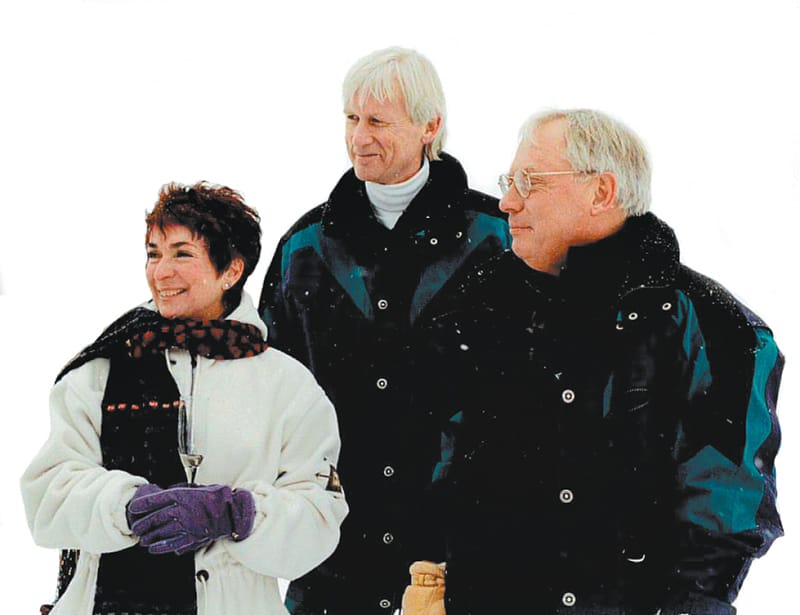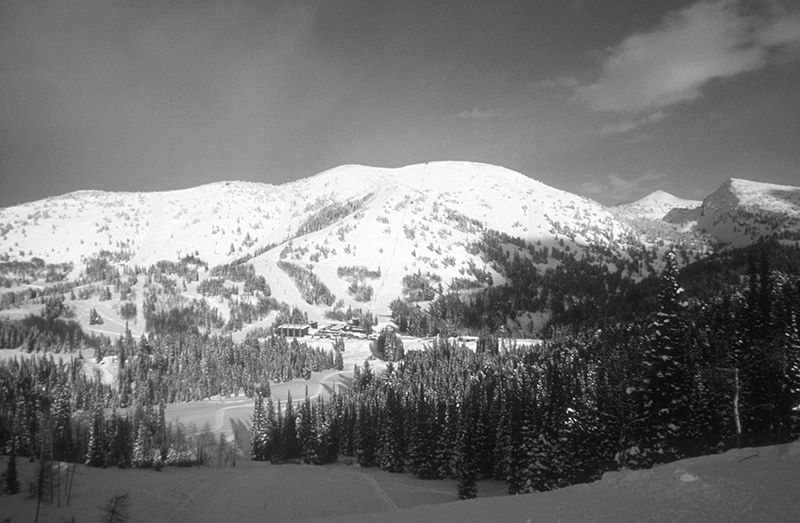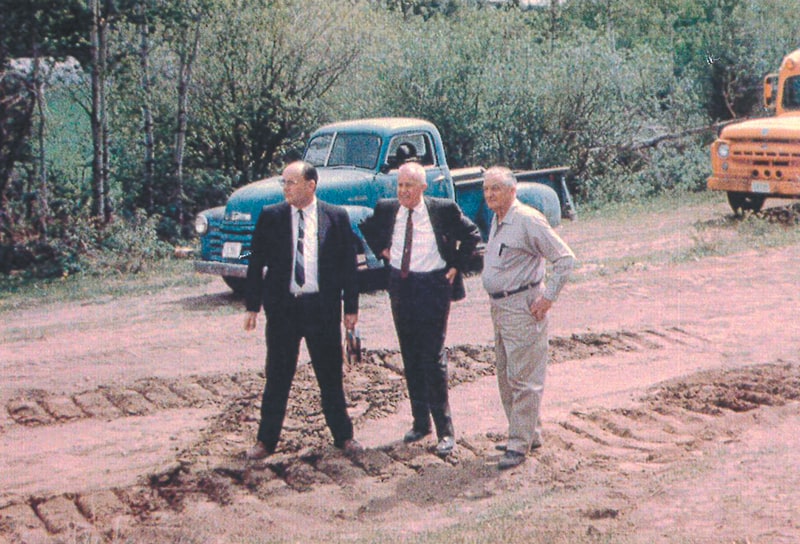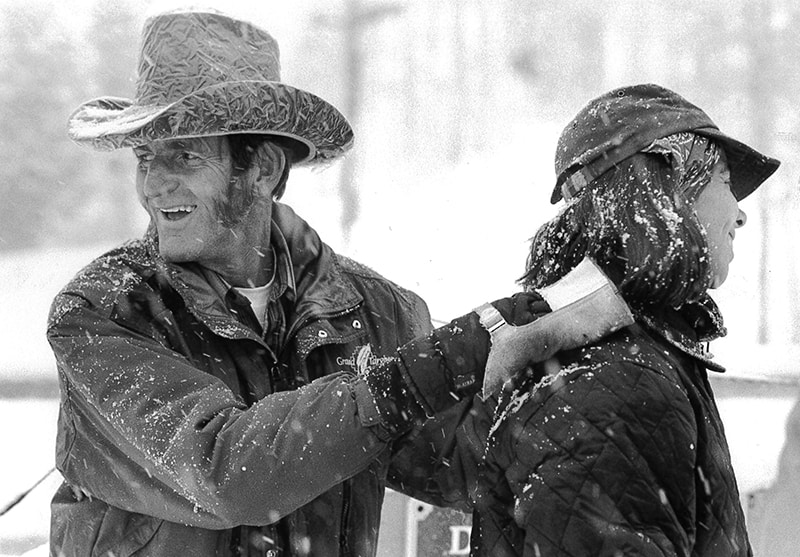Read The
Current Issue
A look (and ski) back in time
Fifty years old in 2019, Grand Targhee is homemade, home to a great skiing culture, and still offers the same homespun feeling it did back in the day.
By Jim Mahaffie

Carol Mann, Mori Bergmeyer, and George Gillett, Jr., father of current general manager Geordie Gillett. Photo by Grand Targhee Resort
“YOU FEEL IT right away,” says Carol Mann of the energy at Grand Targhee Resort, the Teton Valley ski area she owned with her ex-husband, the late Mori Bergmeyer, from 1987 to 1997. “It’s very down to earth with no scene, no fashion show, and no pretense. Just great snow and scenery.” Which is pretty much what you’d expect of a ski area founded by ranchers and potato farmers.
Teton Valley is the basin on the western side of the Tetons that is mostly in Idaho; the easternmost part, however—including Grand Targhee—is in Wyoming. In the 1950s and ’60s the valley had a population of about 2,000. Most residents were Mormon farmers and ranchers. After the fall harvest, the valley pretty much shut down. Between 1950 and 1960, Teton County, Idaho (which includes about 95 percent of Teton Valley’s residents) experienced a 17.6 percent drop in population. Business leaders wondered what could be done to attract more people to the valley, and keep them busy beyond summer.
“PEOPLE HAD BEEN hiking up and skiing Fred’s Mountain for years,” says Jonathan McLaren, who started working at Grand Targhee in 1992 as a freelance accountant and in 1997 became the resort’s controller. “All the spud farmers said, ‘We gotta do something on that hill.’”
When Teton Valley locals wanted to ski, they went to places like Bear Gulch Ski Basin in Ashton, which was one of Idaho’s 25 ski areas at the time, or to the newly opened (1965) Jackson Hole Ski Corporation (today the Jackson Hole Mountain Resort). Sun Valley, the dream of Count Felix Schaffgotsch and Union Pacific Railroad chairman Averell Harriman, was the jewel of Idaho’s ski resorts. Created in 1936, the goal of Sun Valley was no less than to be the “Grand American Ski Resort.” Like Aspen, Colorado, which opened 10 years after it, Sun Valley lured Hollywood stars, regular tourists—and money.
Maybe a ski hill would boost Teton Valley’s economy too?
In 1966, Evan Floyd and Sverre Engen scouted Fred’s Mountain and drew up a prospectus for the local Area Redevelopment Administration. Floyd was a local mail carrier, heavy equipment operator, and president of the Chamber of Commerce. Norwegian-born Engen was a ski jumping champion from Utah who helped build ski hills across the West and was an Alta Ski School director. (He went on to be inducted into the National Ski Hall of Fame in 1971.)
The prospectus said a resort could be built for $1 million, or about $6.7 million in today’s dollars. It would pay for chairlifts that could carry 600 people an hour up 2,000 vertical feet, a lodge, parking for 200 cars, and warming and lounging spaces. Also included in the price was the clearing of ski runs and water and sewage systems. And, as reported in the Teton Valley News, the new resort’s views would be stunning—of “cloud-piercing peaks, portions of Alaska Basin and the checkerboard pattern of farmlands in Teton Basin.”
In 1966, Ski Hill Road was completed and the Forest Service granted a permit for the proposed ski area of Grand Targhee Resort, Inc. Water, sewer, and electric lines were run to the new base area. Critical was a Farmers Home Administration (FHA) loan of $600,000. An additional $100,000 was raised by selling ownership shares to several hundred Teton Valley residents: “Ski at Targhee and Touch the Tetons” pronounced a February 1967 Teton Valley News headline.
Grand Targhee Resort opened the day after Christmas in 1969. Hinting at one of the main attractions the resort would become famous for, opening day was a powder day. More than 2,000 skiers each paid $4.75 to ride the Bannock and Shoshone lifts. Season ski passes cost $75. Six weeks later, Idaho Governor Don Samuelson traveled to Teton Valley to officially dedicate the resort. The Sioux Lodge opened in 1971.
BY 1973, THE resort was struggling financially, and was sold for its debts by the original stockholders to Cincinnati, Ohio, industrialist William Robinson (who invented resealable plastic cups and lids). Robinson and his family split time between Ohio and a home in Driggs. After William died in 1979, his family flirted with selling the resort for several years, but it wasn’t until almost a decade later that Mori Bergmeyer and his wife Carol Mann bought Grand Targhee. Bostonians, Mann was in management development and Bergmeyer was an architect and teacher at Harvard and the Massachusetts Institute of Technology. In 1987 the avid skiers had had a trip to Sun Valley planned, but couldn’t find a place to stay there. A friend suggested the couple ski Grand Targhee instead. For Mann, the resort’s scenery, amazing snow, and friendly folks struck her immediately. “But not the physical facilities,” she says. “It was a true hidden, rough gem.”
After dining at Targhee’s base lodge, the couple approached Eleanor and David Robinson’s table to discuss consulting for them. Mann thought it would “be fun to polish this place.” But the Robinsons were looking for more than consultants: they explained they wanted to sell the resort. Bergmeyer and Mann had already been talking about cashing out and leaving Boston. “We ran the numbers and decided to buy it,” Mann says.
Under their ownership a new high-speed quad was built. Snowboarding, dogsledding, and horse-drawn sleigh rides were introduced. The Sioux Lodge was renovated. Bergmeyer, an innovator and entrepreneur, was so involved with the renovation that he founded Bergmeyer Furniture to create pieces for the resort’s shops and lodging, which were all eventually remodeled.
THINGS SEEMED TO be proceeding to Mann’s and Bergmeyer’s plans until, in 1990, while on a holiday in Europe, they got a call that there had been a fire and major damage to base area buildings. Returning home immediately, they set up tents, put in grills and picnic tables, and kept the lifts going until the end of the ski season. Then they rebuilt the entire base area in a design by Bergmeyer. “Our focus was always on maintaining the beauty of the land, supporting the authentic warmth of the employees, and creating intimate, welcoming Western architecture and design at the base,” Mann says.
In 1997, Booth Creek Holdings, a Gillett family company, purchased Grand Targhee. In 2000 the Gilletts bought the resort from the family company outright via a handshake deal made at Nora’s Fish Creek Inn in Wilson (the handshake was followed later that day by a handwritten letter of agreement).
Today, Geordie Gillett is Grand Targhee’s general manager. He remembers the first time he skied Targhee and how it blew him away. While riding the Bannock lift, which was a two-person double chair in 2000, he remembers thinking he’d never seen anything like Grand Targhee. (And the Gillett family knows ski resorts: Geordie’s father George owned Vail Resort in the 1980s.) “We bought Grand Targhee because it’s so unique and different,” says Gillett, who still owns the resort and is sometimes found stoking fires in the Sioux Lodge, clearing rope lines, helping at kids’ ski races, and, of course, skiing.
Under the Gillett family’s ownership, changes at Targhee have been incremental. The Dreamcatcher high-speed detachable quad chair was installed and the Shoshone lift was replaced with a fixed-grip quad. An ever-growing network of bike trails was added, and Targhee Fest was founded in 2005. This mountain lifestyle and music festival held each July draws attendees from across the West and beyond.
Today it looks like the pace of change is about to accelerate. A major expansion plan includes new restaurants, more snowmaking, three new chairlifts, and a 50 percent increase in skiable acreage. Summer activities will also be expanded to include a zip line and aerial adventure course. Gillett says work on these could begin as soon as this coming summer. But don’t think this means Targhee is forgetting its roots. “[Targhee] is just a really cool place,” Gillett says. “It’s not like Sun Valley or Steamboat, and we don’t want it to be.” JH
DID YOU KNOW
Grand Targhee is renowned for the quantity and quality of its snow. Its average annual snowfall is more than 500 inches. Targhee has never received less than 58 inches of snow in January or 41 inches in February since 1977.
The name “Grand Targhee” honors both the Grand Tetons and Chief Targhee of the Bannock tribe. (Chief Targhee also has a national forest, mountain pass, and creek named after him, and was renowned as a wise and peaceful leader of his people.)
Grand Targhee is the only ski area in North America with a perfect record of being in full operation by Christmas Day since records have been kept starting in the 1970s.
In 2006, Grand Targhee was the site of extreme skier Jamie Pierre’ssuccessful attempt to set a world record for the tallest cliff jump on skis: He skied off a 255-foot cliff in the resort’s backcountry. He landed headfirst and had to be dug out by friends, but only suffered a bloody lip.

Fred’s Mountain and the area that would become Grand Targhee Resort were first scouted in 1966 with hopes of bolstering Teton Valley’s seasonal economy. Photo by Rickers Film Production

Evan Floyd, right, first scouted Fred’s Mountain for potential development in 1966. Photo by Grand Targhee Resort

Leon “Slim” Weston was a larger-than-life, beloved Targhee liftie and resort ambassador for 45 years. He was Targhee’s first employee, later appeared in the Warren Miller film Extreme Winter, and was at work up to several days before his death in 2014. Photo by Garth Dowling




